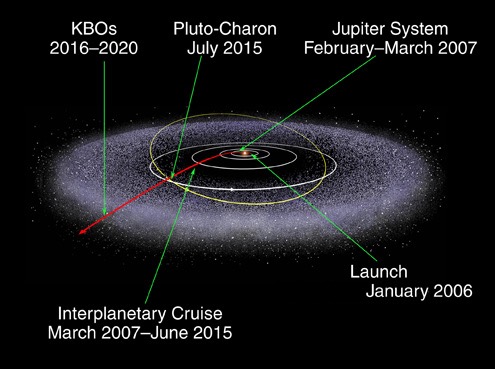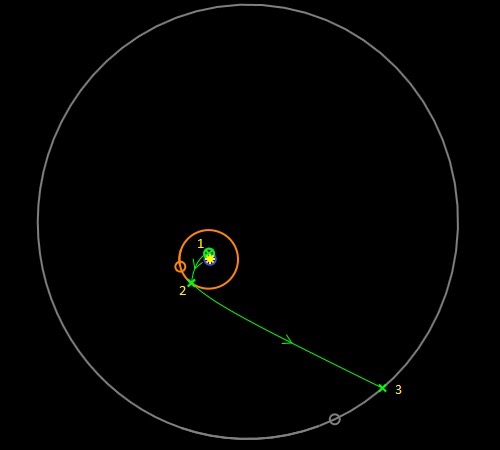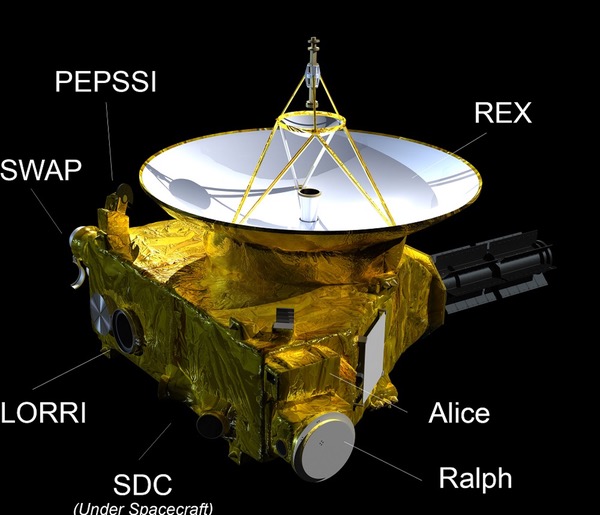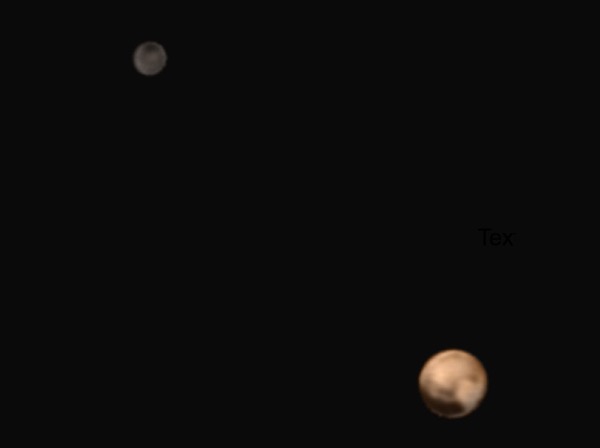What about the next Pluto mission?by Andrew J. LePage
|
| It could be argued that even another “fast flyby” mission to Pluto like New Horizons would be scientifically justified as well as being more affordable. |
After waiting the better part of a lifetime, we have finally reached Pluto (now demoted to “dwarf planet” status) with NASA’s New Horizons spacecraft some 45 years after I first read about a mission to this distant world in National Geographic. Even though we have yet to see what the instruments of New Horizons will discover about this distant outpost of the solar system and its family of moons, now is as good as time as any to start thinking seriously about the next mission to Pluto. Given the infrequent availability of low-energy launch opportunities and the long flight times to Pluto, along with with the lengthy process of proposing planetary missions, gaining the required support and funding, and actually building the hardware, it will likely be decades before we visit Pluto again. While ideally a follow-on mission should be an orbiter, such missions are much more expensive and will have longer transit times. It could be argued that even another “fast flyby” mission to Pluto like New Horizons would be scientifically justified as well as being more affordable.
 A diagram of a potential JGA trajectory for the next mission to Pluto. 1) Launch from Earth in Dec 2028, 2) Jupiter flyby in May 2030 and 3) Pluto encounter in Jan 2039. (credit: NASA/Ames Trajectory Browser) |
Trajectory options
There are many potential options available for realistically launching a usable payload to Pluto using currently available propulsion technology. The simplest trajectory option for reaching Pluto is a direct flight from Earth. And since the positions of the Earth and Pluto line up to allow favorable launch windows about once every year, it is the most frequently occurring option. While a direct flight from Earth to Pluto is technically feasible, it is among the least attractive options, however.
Direct flights to Pluto have large launch energy requirements and trip times of a decade or more. In fact, among the backup launch options considered for the New Horizons mission was a direct trajectory to Pluto, with the penalty of up to five additional years of travel time to reach its target. As an added complication, since Pluto is moving farther from the Sun in its highly elliptical orbit since reaching perihelion in 1989, and will be moving farther out of the ecliptic plane after crossing it in 2018 as a result of its high orbital inclination, the launch energy requirements and travel times for the direct flight option will only continue to grow over the course of the next century, making it an increasingly less favorable option as time goes on.
One means of decreasing the launch energy requirements and trip times for a Pluto mission is to employ gravity assisted trajectories, where one or more flybys of various planets are used to boost the velocity of the spacecraft. The simplest of these options, and the one employed by the New Horizons, is a Jupiter gravity assist, or JGA. But because of the slow motion of Jupiter around the Sun, the proper alignment between Jupiter and Pluto for the JGA option only occurs for a couple of years every 12.5 years. According to the Mission Design Center’s trajectory browser maintained by NASA Ames Research Center, there are very favorable launch windows for JGA trajectories for a Pluto flyby mission late this year and again late next year. Obviously, this is insufficient time to mount a new mission.
The next favorable launch opportunity to Pluto using a JGA trajectory comes at the end of 2028 and the beginning of 2029. One of the better options currently listed in the trajectory browser calls for a launch on December 31, 2028, with a characteristic energy, or C3, of 120 km2/s2. Just to get a sense of the size of this launch energy requirement, this C3 is about an order of magnitude larger than is typically required for missions to Venus or Mars. Despite its large size, this is still lower than the C3 of about 166 km2/s2 for New Horizons launched in January 2006 because this mission could not be ready in time for the more energetically favorable launch window in December 2004. As a result, even if a follow up mission to New Horizons used the same Atlas V launch vehicle and Star 48A kick stage (or the future equivalent), it could launch a heavier payload towards Pluto than the 478-kilogram (1,054-pound) New Horizons spacecraft if it were to use this trajectory option.
 The Jupiter gravity assist (JGA) trajectory of the New Horizons mission to Pluto. (credit: NASA/JHU-APL/SwRI) |
After launch, a “fast flyby” mission like New Horizons following this JGA trajectory would continue on to pass by Jupiter on May 11, 2030, with a closest approach altitude of 2.08 Jupiter-radii, or just inside the orbital distance of Io. This would offer a better vantage point to observe Jupiter and its moons than was afforded by the more distant 32 Jupiter-radii encounter of New Horizons in 2007. The encounter with Pluto would take place about 8.5 years after leaving Jupiter on January 28, 2039, at a relative velocity of 18 kilometers per second (11 miles per second), compared to New Horizons’ encounter velocity of 11 kilometers per second (9 miles per second), for a total trip time of 10.1 years, compared to New Horizons’ 9.5 year trip time. Just as is the case with New Horizons, this encounter speed is far too fast for an orbit insertion to be practical using a chemical propulsion system. While there are options to decrease the encounter velocity, this trade comes at the cost of a significant increases in travel time—on the order of up to a decade or more. So unless there are some huge breakthroughs in the next decade or so in nuclear-based propulsion, coupled with an equally huge breakthrough in the levels of funding available for planetary missions, any follow on mission to New Horizons is either going to be an orbiter employing a chemical propulsion system with a flight time on the order of a couple of decades, or another flyby like New Horizons with a decade-long time of flight.
| Given that it took over a decade and a half with several cycles of planning and proposing before a Pluto mission was finally approved and launched, it will likely be the late 2020s before a follow-on mission is finally launched. |
There are also other trajectory options to reach Pluto that could be available. There are Venus-Earth gravity assist (VEGA) options to decrease the launch energy requirements substantially for the JGA option, allowing a smaller launch vehicle to be used and/or increase the spacecraft’s mass. But these options would either lengthen the already long total trip time by a couple of years or more or increase the encounter speed with Pluto. There are also likely to be low-launch energy VEGA trajectory options that do not entail a JGA that occur more frequently and could be launched earlier in the 2020s, but they remain to be worked out in detail. Energetically favorable options that would include a Saturn gravity assist, which occur even less frequently than JGA opportunities, will not be available again until the early 2040s—too late for our purposes.
Given that it took over a decade and a half with several cycles of planning and proposing before a Pluto mission was finally approved and launched, it will likely be the late 2020s before a follow-on mission is finally launched. While earlier launch dates are possible, for the purposes of this essay, I am assuming that a late-2028/early-2029 launch date for a JGA trajectory is the more probable option and that a repeat of the New Horizons’ flyby mission will be flown.
 Diagram of the New Horizons spacecraft with its instruments labeled. A follow on mission to Pluto would benefit from a quarter of a century of advancements in technology and remote sensing techniques. (credit: NASA/JHUAPL/SwRI) |
Mission justification
So why should we be thinking about a return to Pluto with another flyby mission? First of all, only about half of this dwarf planet will be observed at moderate to high resolution during this encounter because of Pluto’s slow 6.4-day period of rotation, coupled with New Horizons’ high encounter velocity. A new mission could observe much of the other half with a properly timed flyby. In addition, New Horizons’ trajectory past Pluto has been constrained by unknown potential hazards, such as debris or rings, that might exist among Pluto’s systems of moons. With the initial reconnaissance of these hazards by the current mission, a follow on mission could be directed closer to Pluto; its largest moon, Charon; or other scientifically interesting targets in the system.
There are other good reasons to return to Pluto as well. Having been an observer of planetary missions for decades, it is a safe bet that for every question New Horizons answers, scientists will come up with more questions about Pluto and its family of moons that will need to be addressed by a new mission. But beyond this, there is the simple fact that Pluto will likely be a very different place in 2039 than the one New Horizons is observing today. Pluto will have traveled through 41 degrees of its orbit during this time, resulting in a marked progression of its seasons. While New Horizons will arrive at Pluto in the late spring of the northern hemisphere, in 2039 it will be early summer and about eight Earth-years after the sub-solar point had reached as high as 60° north latitude due to the 120-degree tilt of Pluto’s rotational axis.
In addition to this change of season, Pluto’s distance from the Sun will have increased from 32.8 to 38.8 astronomical units (AU; one AU is approximately 150 million kilometers) during the intervening years, resulting in a 28-percent decrease in the amount of heat the dwarf planet receives from the Sun. Because of this, many astronomers believe that Pluto’s atmosphere may begin to freeze out or collapse by 2020, forming fresh deposits of volatile ices in the unlit southern polar region. Getting New Horizons to Pluto before this date was an important driver in the choice of trajectory for this mission.
In recent years, new models of the seasonal evolution of Pluto’s atmosphere that agree better with measurements of how it has changed over the past quarter century suggest, however, that Pluto’s atmosphere will not collapse as predicted and might even thicken towards a maximum value around 2040 (near the time of this proposed Pluto follow-on flyby), depending on the dwarf planet’s inventory of volatile ices and the properties of the atmosphere. No matter which of the models developed in recent decades proves to be correct, it is clear that Pluto’s atmosphere and surface deposits vary on times scales of decades as a result of the interplay of the seasons and the variations in its distance from the Sun. A new set of close-up observations of Pluto about a quarter of a century after New Horizons will provide vital clues about the seasonal changes on Pluto and the processes that drive them. And given the long orbital period of this distant world, this will be humanity’s only chance to observe Pluto during this crucial phase of the northern summer/southern winter for another 248 years.
| Depending on the available payload margin and, just as importantly, the new mission’s budget, it may prove possible to carry several lightweight but very capable sub-probes that the main spacecraft could deploy weeks or months before its 2039 Pluto encounter. |
In addition to changes on Pluto that would be observed, a follow-on mission will also benefit from almost a quarter-century’s worth of advances in technology and remote sensing techniques. The instrument payload of New Horizons, as impressive as it is, does not include everything scientists would have wished and was limited by the available payload capabilities of the launch vehicle chosen for a less-than-ideal launch window to Pluto. Advances in technology, coupled with a more favorable launch window in 2028, should allow a more massive and capable set of miniaturized instruments to be carried by New Horizons’ successor, assuming the equivalent of an Atlas V-Star 48A launch vehicle is used again. With the results of the New Horizons mission in hand, new instruments designed to address new questions about Pluto could be carried. Advances in data storage and space communication technologies should also allow more data to be collected and transmitted back to Earth faster than is possible with New Horizons.
Depending on the available payload margin and, just as importantly, the new mission’s budget, it may prove possible to carry several lightweight but very capable sub-probes, with masses perhaps on the order of tens of kilograms, that the main spacecraft could deploy weeks or months before its 2039 Pluto encounter. These lightweight sub-probes could be directed to make observations of Pluto, Charon, or its other moons at closer range or under different viewing conditions than might be possible with the main spacecraft. This tactic would add flexibility to mission planning as well as the quantity and quality of the scientific data returned. While a traditional entry probe would be of little use in the thin atmosphere of Pluto (which has an estimated surface pressure on the order of a few microbars), a properly equipped sub-probe could be aimed to fly hundreds or maybe even tens of kilometers above Pluto’s surface to directly sample its atmosphere and any aerosol or cloud layers that may exist.
An important secondary objective of the New Horizons mission has been a close encounter with an object in the Kuiper Belt. While astronomers have finally identified a couple of suitable targets, this process took much longer than expected. Given the difficulties with locating such a target even after years of searching, more time and effort probably should have been allotted to this important task. With the added benefit of a quarter-century of extra time and advancements in astronomical instrument technology, there is a much higher likelihood of identifying one or more potential better Kuiper Belt targets that a new Pluto mission could also study at close range, adding to the science return of its mission.
More missions?
With all these factors taken together, there would seem to be a justification for launching a second flyby mission to Pluto around 2028 with an encounter date of about 2039. Considering the time it took from proposing the first mission to Pluto to the time that mission is actually about to reach this distant world, now is a good time to start thinking seriously about a second mission to Pluto. Some might point out, and rightfully so, that higher priority targets in the outer solar system, such as Uranus and Neptune, should be revisited before another mission is sent to Pluto. If a choice has to be made, obviously the higher priority ice giants should be selected, especially given their importance in understanding the increasing numbers of like-sized extrasolar planets being discovered. But so far, several proposals in recent years to launch missions to Uranus in the early 2020s have failed to generate the needed support. While studies to launch missions to Uranus and Neptune continue, they are now generally considering encounter dates well into the 2040s or later.
Interestingly, celestial mechanics may offer us an affordable solution to explore the ice giants as well as launch a follow up mission to Pluto. According to the Mission Design Center’s trajectory browser, there are a number of energetically favorable JGA launch windows in the early 2030s to send flyby spacecraft to Uranus or Neptune with arrival times in around 2040—about a half a century after the initial reconnaissance of these worlds by Voyager 2 and well before any mission currently being studied will likely reach them (see “The Grand Tour: Uranus” and “The Grand Tour Finale: Neptune” in The Space Review, January 24, 2011 and August 25, 2014, respectively). The C3 launch energy requirements for these windows are in the 85 to 105 or more km2/s2, which are a bit more modest than the 2028–29 Pluto launch window. This allows a slightly more massive spacecraft to be sent towards these targets if the same launch vehicle is employed. While a more expensive orbiter mission would be preferred, a flyby mission would still be scientifically valuable, especially considering these new spacecraft will have the benefit of over fifty years of technological advancement over the Voyager spacecraft.
I would suggest that perhaps three separate spacecraft be launched towards Pluto, Uranus, and Neptune in the 2028 to 2034 timeframe to take advantage of the JGA launch windows with the instrument mass and complement tailored to each target. Since the launch energy requirements to reach Uranus and Neptune are a bit more modest than for Pluto, it may even prove possible for these craft to carry small entry probes to directly sample the atmospheres of these worlds. With a “bulk buy” of three spacecraft and launch vehicles, as well as combined mission operations, it should prove possible to explore all three of these worlds together for much less money than it would cost for three separate, independently run missions. If the incremental cost of additional launches is acceptable, it may prove possible to launch missions toward other objects in the Kuiper Belt during this same time frame.
| Having waited so long to finally see Pluto and with memories as a young adult of Voyager’s encounters with Uranus and Neptune, these fast flyby missions may present the last time to explore these distant worlds in my lifetime. |
Given all of the trajectory options available during this period, any number scenarios can be constructed to meet mission requirements. One possible scenario could look like this: On December 31, 2028, the first mission is launched towards Pluto via Jupiter as described earlier. On March 11, 2031, the Neptune-bound spacecraft is launched with a launch energy of 85 km2/s2. A few weeks later, on March 27, 2031, the third spacecraft destined for Uranus is launched with about the same launch energy. On October 7, 2032, the Neptune-bound spacecraft comes within 5.1 radii of Jupiter two and a half years years after the Pluto flyby craft’s encounter. As before, the spacecraft could exercise its instruments and make useful observations of Jupiter at this time. Another two and a half years later, on March 22, 2035, the third spacecraft would come within 1.07 radii of Jupiter’s cloud tops and is flung towards Uranus.
The first spacecraft to reach its target is the Pluto flyby mission in January 2039. The encounter with Uranus would take place almost two years later on November 14, 2040. The second spacecraft launched would finally reach Neptune three months later on February 18, 2041. After the missions with the primary encounter targets are completed, all three spacecraft could be targeted to flyby objects of interest in the Kuiper Belt, just as New Horizons will do. And given the relatively large mass of Uranus and Neptune, the trajectories of their flyby craft could deflected to encounter bodies well out of the ecliptic plane.
While I readily admit that these fast flybys of Pluto and the ice giants will not produce the same amount of science as dedicated orbiter missions, they should provide valuable scientific data on these distant worlds before the preferred orbiter missions are likely to reach them by mid-century or beyond. And on a personal note, having waited so long to finally see Pluto and with memories as a young adult of Voyager’s encounters with Uranus and Neptune, these fast flyby missions may present the last time to explore these distant worlds in my lifetime.
General references
Robert Farquhar and S. Alan Stern, “ Pushing Back the Frontier: A Mission to the Pluto-Charon System”, The Planetary Report, Vol. 10, No. 4, pp. 18-23, July/August 1990
Yanping Guo and Robert W. Farquhar, “New Horizons Mission Design”, Space Science Reviews, Vol. 140, No. 1-4, pp. 49-74, 2009
C.B. Olkin et al. “Evidence that Pluto's atmosphere does not collapse from occultations including the 2013 May 04 event”, Icarus, Vol. 246, pp. 220-225, January 2015
